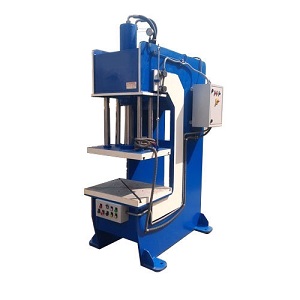Posted on 18th Jun 2024
Unlocking Precision and Power: The Hydraulic Press Machine

In the realm of industrial machinery, few tools boast the versatility and sheer force of the hydraulic press machine. This stalwart device has been integral to manufacturing processes across various sectors for decades, offering unparalleled power for shaping, molding, and compressing materials with precision. Let’s delve into the workings, applications, and advancements of the hydraulic press machine, a cornerstone of modern manufacturing.
Understanding the Hydraulic Press Machine
1. Mechanics and Functionality
- Hydraulic System: Central to its operation is a hydraulic system comprising a fluid-filled chamber and pistons. When hydraulic fluid is pressurized, it exerts force on the piston, transmitting immense pressure through a confined space.
- Force Multiplication: By leveraging Pascal’s principle of fluid pressure transmission, hydraulic presses multiply input force to generate significant output force, making them capable of exerting hundreds to thousands of tons of pressure.
2. Components and Types
- Frame: Typically constructed from heavy-duty steel, the frame provides stability and withstands the immense forces generated during operation.
- Cylinder and Piston: These components translate hydraulic pressure into mechanical force, crucial for performing tasks such as stamping, forging, and forming metal sheets.
- Control Systems: Modern hydraulic presses incorporate advanced control systems for precise operation, including pressure and stroke controls, ensuring accurate and repeatable results.
Applications Across Industries
1. Manufacturing Sector
- Metal Forming: Hydraulic presses shape metal components through processes like deep drawing, bending, and extrusion.
- Compression Molding: Used extensively in the automotive and aerospace industries for manufacturing composite materials and structural components.
- Assembly Operations: Hydraulic presses facilitate the assembly of parts through riveting, bonding, and joining processes.
2. Construction and Infrastructure
- Concrete Production: Hydraulic presses manufacture concrete blocks, paving stones, and bricks by compacting aggregates and cement mixtures.
- Bridge Construction: Used in fabricating and joining structural steel components for bridges and other large-scale infrastructure projects.
3. Consumer Goods and Beyond
- Rubber and Plastics: Hydraulic presses mold and shape rubber and plastic materials, producing items such as gaskets, seals, and consumer products.
- Woodworking: From furniture production to veneer pressing, hydraulic presses ensure precise shaping and assembly of wooden components.
Advancements and Future Outlook
Innovation continues to drive the evolution of hydraulic press technology. Advancements in automation, robotics, and digital control systems enhance efficiency, safety, and adaptability across diverse applications. Additionally, eco-friendly initiatives focus on reducing energy consumption and minimizing environmental impact, positioning hydraulic presses as sustainable choices in modern manufacturing.
Conclusion
The hydraulic press machine available on CM Industry Supply Automation stands as a testament to engineering ingenuity and industrial prowess. Its ability to generate immense force with precision has revolutionized manufacturing processes worldwide, shaping everything from everyday consumer goods to critical infrastructure. As technology advances and industries evolve, the hydraulic press remains indispensable, powering the production of tomorrow’s innovations while upholding standards of quality, efficiency, and reliability.
